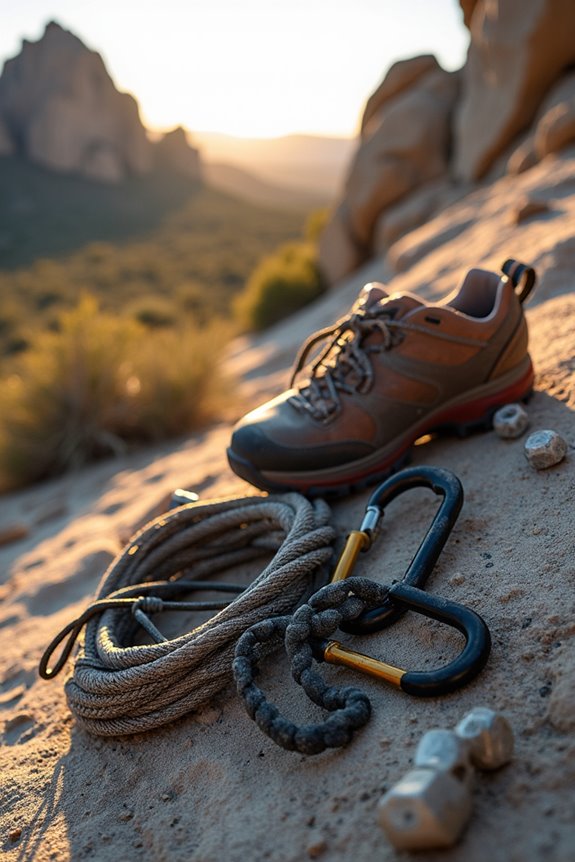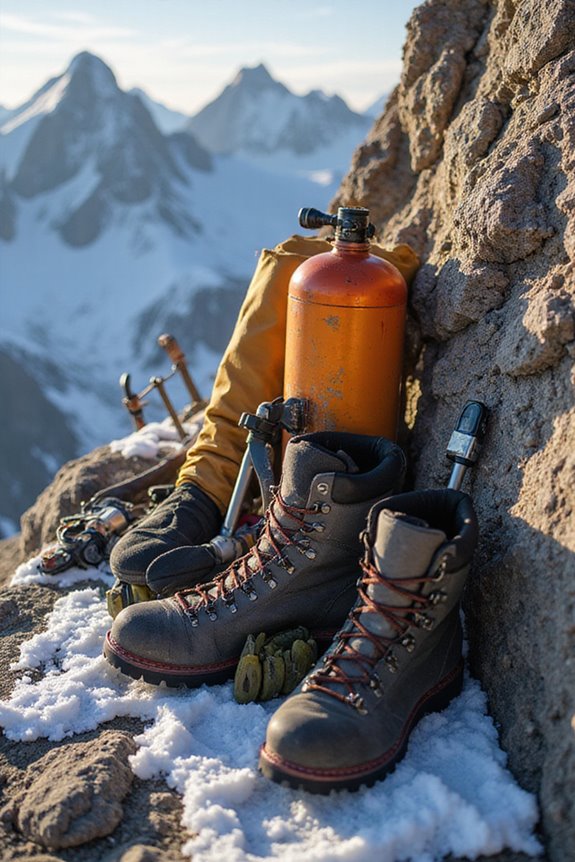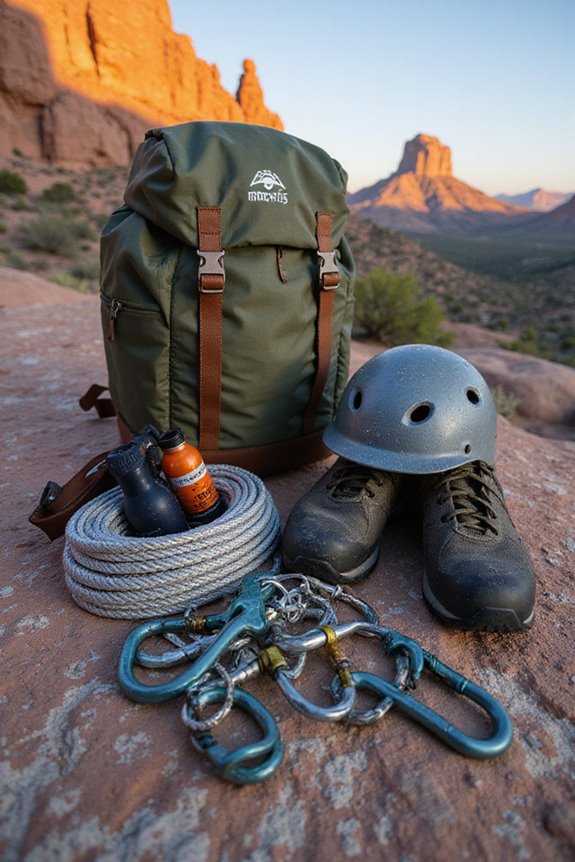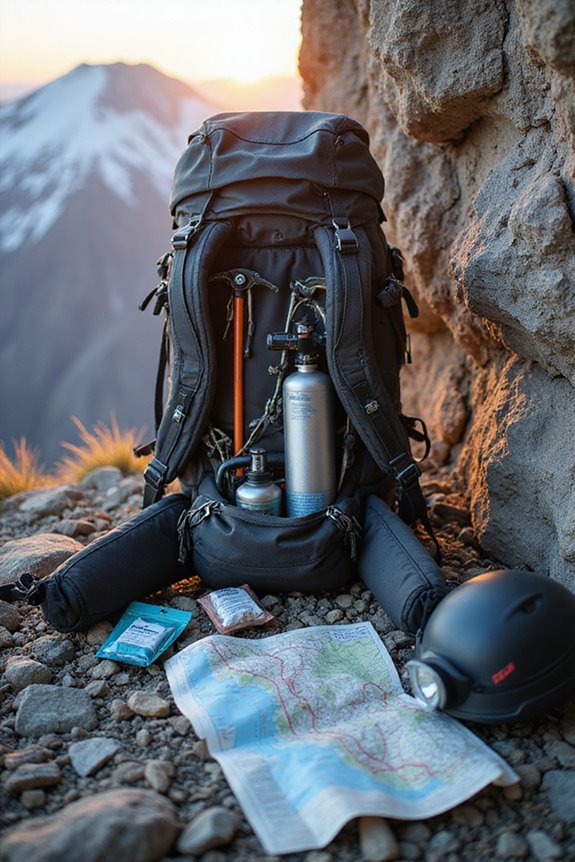When we hit the crag, having the best gear for rock climbing makes all the difference! A well-fitted pair of climbing shoes boosts our confidence on those tricky routes. Don’t forget a solid backpack like the Osprey Talon 26L for organizing our essentials. Safety’s key, so we need proper protection devices, and choosing the right ropes can keep us secure on our ascent. Gear up right, and you’ll be ready for any challenge—stay tuned to discover even more must-have items!
Key Takeaways
- Choose well-fitted climbing shoes (aggressive, moderate, or neutral) for optimal performance and comfort on challenging routes.
- Organize your gear in a solid backpack like the Osprey Talon 26L for convenient day trips and efficient access.
- Invest in both active (cams) and passive (nuts) protection devices for versatile and safe climbing setups.
- Select the appropriate type of rope for your climbing style, ensuring it’s well-maintained to prevent tangles and ensure safety.
- Wear moisture-wicking clothing with UPF protection to keep comfortable, dry, and safe from UV rays during climbs.
Essential Rock Climbing Gear
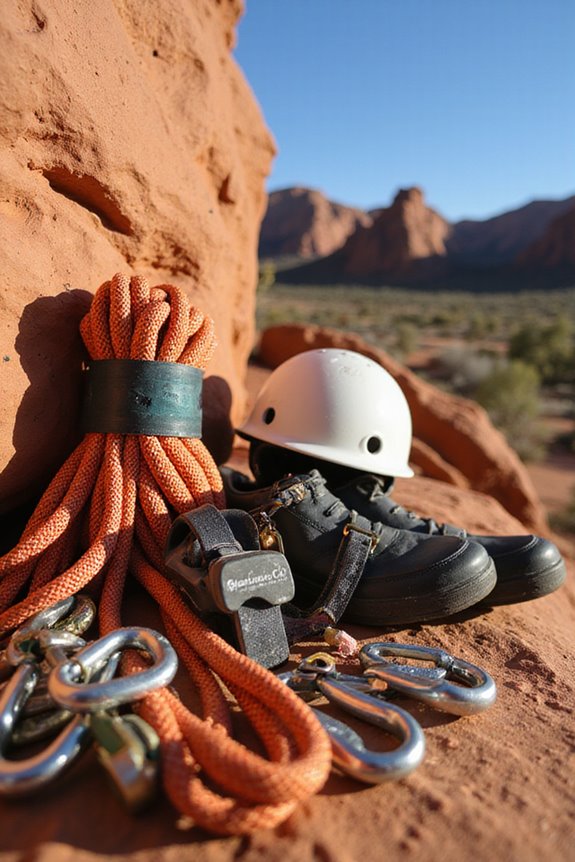
When we set out on a rock climbing adventure, having the right gear can make all the difference between a great day and a total flop. One of the first things we need to nail down is our climbing shoe types. From aggressive to neutral shoes, finding that perfect fit gives us the confidence to conquer those tricky routes. We shouldn’t forget about approach shoes for our hike to the crag—what a relief they are!
Now, let’s talk gear organization. A solid backpack keeps our essentials tidy, whether it’s chalk bags, ropes, or helmets. Trust me, digging through a chaotic pack is about as fun as a rainy day on the rock! Staying organized not only saves time but also fuels our sense of adventure. For day climbing trips, consider the Osprey Talon 26L with its AirScape suspension system that provides excellent comfort while carrying your climbing equipment.
Protection and Anchoring Equipment
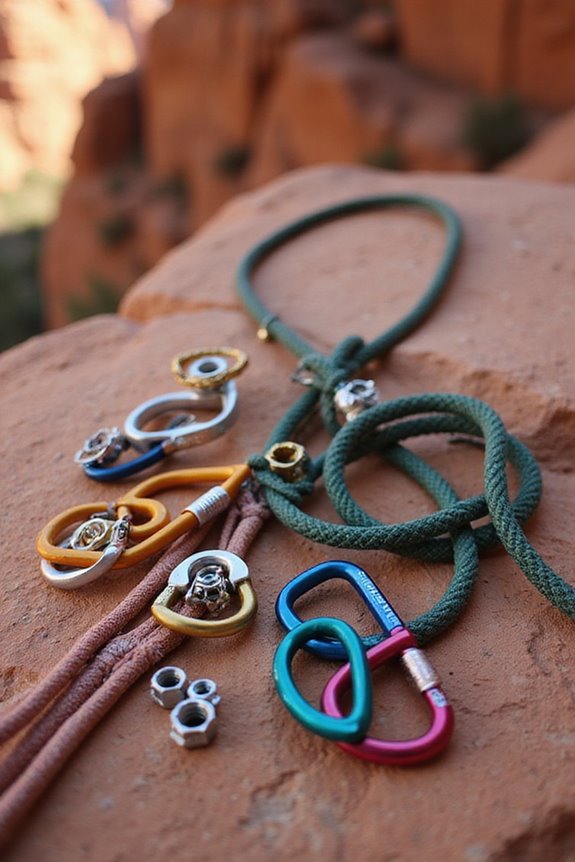
As we plunge into the heart of protection and anchoring equipment, it’s absolutely vital to understand that a well-placed piece of gear can be a climber’s best friend. Choosing the right protection device is key! We’ve got active devices, like spring-loaded cams that expand to grab onto cracks, and passive ones, like trusty nuts that fit snugly in constrictions. Mixing these offers incredible versatility! Some climbers carry Katadyn water filters for staying hydrated during multi-pitch routes where water sources might be questionable. When we set up our anchors, we need to employ solid anchoring techniques—using multiple pieces of pro guarantees safety and distributes that load like a pro. And hey, always inspect your gear—nobody wants a surprise on the wall! With solid placements, we can embrace the freedom of climbing with peace of mind. Let’s go for it!
Ropes and Rope Management
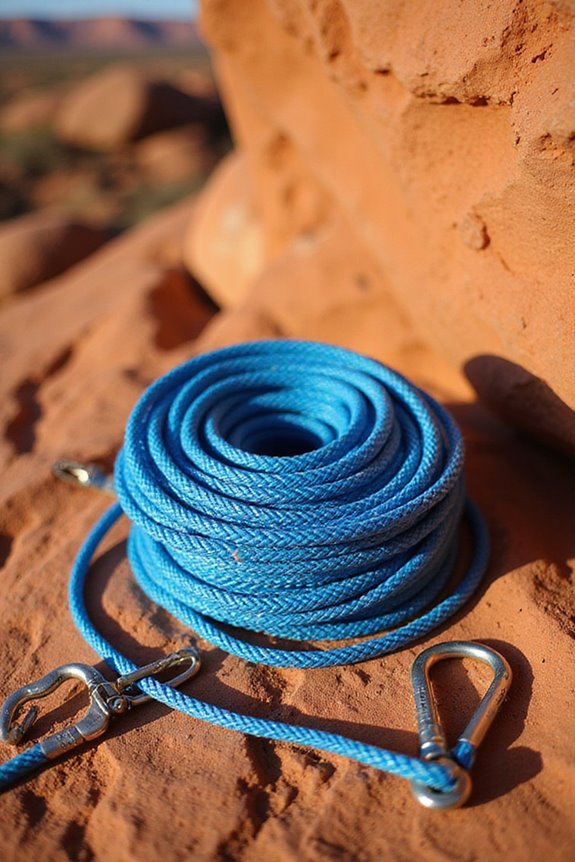
Ropes can make or break a climbing adventure—literally! We’ve all felt the thrill of a climb, but it’s the right rope that keeps us safe. When considering rope selection strategies, think about the type of climbing. For sport routes, a dynamic single rope is our best bet, but for alpine adventures, half or twin ropes are key. Remember, proper rope maintenance techniques—like regular inspections and using butterfly coils—prevent unexpected tangles. And don’t forget, our ropes need to match the route; longer climbs call for longer ropes. Similar to tents with double-stitched seams that ensure durability in harsh conditions, quality climbing ropes require reinforced construction to withstand abrasion and stress. Keep them dry, handle them with care, and always communicate with our climbing partners. With these tips, we can guarantee our ascent is an exhilarating journey of freedom, not a knotty nightmare!
Clothing and Personal Protection
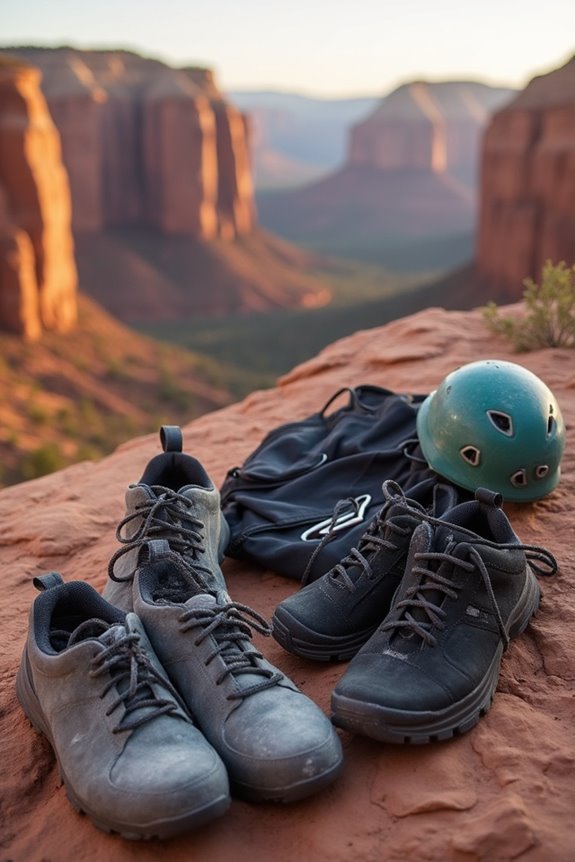
It’s amazing how the right clothing and personal protection can elevate our climbing experience, making us feel both confident and prepared. When we embrace the latest climbing apparel trends, we not only look good but also benefit from moisture management techniques that keep us dry. Trust me, a wicking T-shirt can be a game-changer, soaking up sweat while we conquer those craggy heights. Look for t-shirts that offer UPF 50+ protection to shield your skin from harmful UV rays during those long days on exposed rock faces. Let’s not forget our climbing pants that allow for ultimate freedom of movement—the last thing we need is to feel restricted while scaling a rock face! And for those sunny climbs, a good sun hat keeps us cool and protects our noggin. So gear up, friends! With the right clothing, we can focus on that sweet feeling of freedom on our climbs!
Safety and First Aid
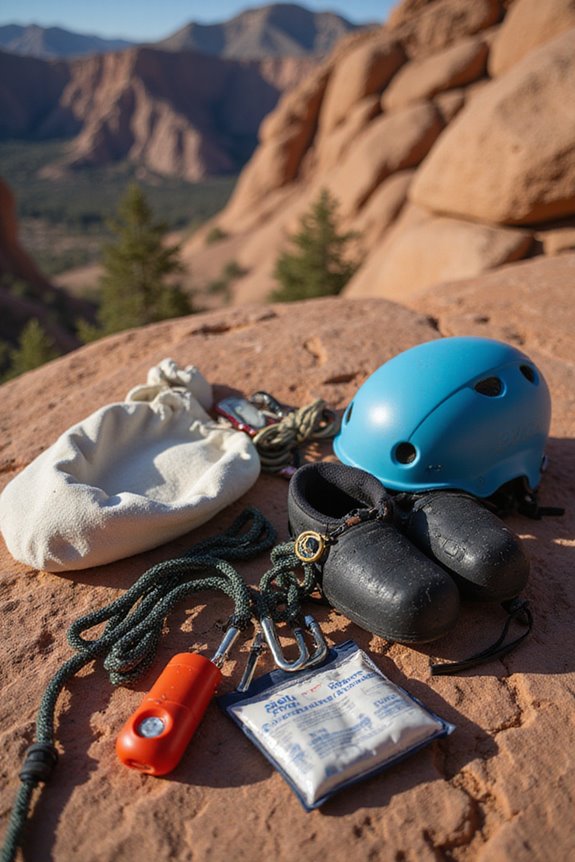
When we’re out there climbing, safety has to be at the forefront of our minds; after all, a thrilling ascent can quickly turn into a nail-biting adventure if we aren’t prepared. That’s why packing a solid first aid kit is a must! We’re talking adhesive bandages for scrapes, antiseptic wipes for those inevitable climbing injuries, and elastic bandages for sprains that seem to sneak up on us. For rock climbing adventures, consider a waterproof first aid kit that can withstand unpredictable weather conditions while keeping your supplies protected and accessible.
Also, let’s not forget about learning basic wound care and immobilization techniques. It can make all the difference when we’re miles from help. And trust us, regularly checking and replenishing our supplies keeps us adventure-ready. So, before we hit the crag, let’s make sure we’re equipped to tackle any bumps along the way!
Specialty Gear for Specific Climbing Styles
Packing the right gear for each climbing style can make the difference between an unforgettable journey and a sheer cliff of frustration. For bouldering, we can’t forget crash pads, climbing shoes, and chalk bags—they’re crucial for sticking those powerful moves! When we tackle sport climbing, quickdraws, dynamic ropes, and a comfy harness keep us safe and agile. Trad climbing calls for trusty cams and nuts, because let’s face it, securing yourself is more important than finishing your coffee. If we’re venturing on multi-pitch climbs, haul bags and portaledges become our best friends. And let’s not overlook alpine gear—ice tools, crampons, and weatherproof clothes are essential here. Prepare right, and freedom on the rocks awaits!
Frequently Asked Questions
How Do I Choose the Right Climbing Shoes for My Foot Type?
When choosing climbing shoes, we’ve gotta embrace a snug shoe fit that feels like a second skin! Let’s explore climbing materials that’ll conquer every crag and make our feet dance with freedom on the rock!
What Is the Difference Between Dynamic and Static Climbing Ropes?
When exploring climbing rope types, we need to understand dynamic and static ropes. Prioritizing rope safety techniques guarantees we’re making the best choices for falls and stability, keeping our climbing adventures safe and exhilarating.
How Often Should I Replace My Climbing Gear?
We should replace our climbing gear every 1-10 years, depending on usage and wear. By staying aware of gear lifespan and safety standards, we can guarantee our adventures remain thrilling and risk-free.
Can I Climb Without a Harness or Helmet?
Like soaring birds, we crave freedom in climbing, but without harnesses or helmets, we risk crashing. Embracing safety precautions guarantees we can enjoy the heights, avoiding the ground’s harsh reality. Let’s climb wisely together!
What Are the Best Practices for Belaying a Partner Safely?
When we talk about belaying techniques, it’s essential to prioritize safety communication. Staying alert, optimizing our stance, and using clear commands help create an atmosphere where both partners can experience climbing freedom without fear.

